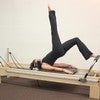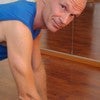Description
This is an advanced class that is safe for those with osteoporosis, however there are a few exercises which are contraindicated. For these exercises, Rebekah offers safe modifications that can be done instead.
About This Video
Transcript
Read Full Transcript
Hello, I'm Rebecca Rotstein and I'm thrilled to be back at Palladio's anytime. This is my sixth year visiting and I'm going to do a reformer workout today on Amy that a bit different from what I've done in the past because just as we all grow every year in our own learning and understanding in our bodies, I have come to a new level in my yoga practice and wanted to integrate some of the things that I do on a daily basis onto some of the reformer workout, particularly because of what it does for the feet and how this program will help you integrate your feet and in healthy alignment of the feet into your daily life. It's also pretty intense on the upper body as well, so I hope you enjoy this. We're going to do a little baseline to begin with, so I want you to test this out as well. So just stand facing me and I'd like you to lift one foot and then you're going to hinge forward just like a yoga warrior three pose and just see how steady you feel. Well, she's pretty good and try it on the other side so everybody do this as well. Part of the reason that I'm having you do this is if you have any kind of ankle or foot instability such as I do. This is one of the hardest things.
I find that because of my tendency to pronate, this is really, really challenging and because of the lack of glide and a in one of my hips, it doesn't sit so well in the socket. This program really resolves that, so let's, let's give it a go. Let's have you lie down. So we're going to begin in footwork in our typical footwork setting, usually three springs, but Amy's not going to begin where she wants to in [inaudible] first. Instead, I'm going to position her feet where her cuboid is resting on the Barb in the foot tutorial that we just filmed. You can learn a little bit more about the positioning and location of the insignificance of that cuboid bone.
So her feet are directly in line with her hips and she's going to push out and you don't, I'm going near your feet just a little bit. When I say directly in line with the hips, I should indicate that I'm talking really about the sockets, the femoral heads and returning back and good and push and in. So the reason that I like this positioning of the cuboid, uh, resting on the bar is that it help restore that lateral arch. But you have to be careful that the feet don't roll in so that the medial arch doesn't necessarily touch the bar. So I'm going to give you just a little feedback.
Sometimes I'll place a little rag under there so that it reminds the feet not to roll in and it also helps restore the neutral positioning of the ankle and one more and then relax back in. Now you can go on to your, your first position that you wanted to be in and push out. I think coming back, and I'll tell you, I've gone through this interesting cycle over the past few years of changing my preference for using pieties first versus parallel balls of the feet and I'm back into my original classical origins of enjoying the plots first with the heels lifted. Because when I do that, I feel it's really intense connection into the ankles that gives me so much terrific feedback of where they need to be and it integrates more through that internal, uh, deep frontline as well. And one more.
Part of my, everybody has, has evolution in their teaching and part of my evolution has been to return to the arches, which for awhile I was avoiding because they're not weight bearing structures, but we're not weight bearing here. So my current belief is let's, let's keep going with the arches. Again, a lot of feedback that comes in through that area. Let's do one more and let's go on to the heels. So remember, this is all preparing us for some of our climactic ending and pushing out and in. So be sure that I like to have the feet directly together as you have them, and then pulling the toes up toward the face as much as possible so you really work through the front of the Shins, through the whole anterior compartment of the leg. Keep pulling those toes up, really active. And that tends to give you a little bit more sensation into the low abdomen area as well. Let's do two more. Now remember, some people may, I'm bow legged. Some people may be more knock kneed and it might not be totally appropriate for their feet to touch while they're doing that, but as close as possible. Now we get into some interesting stuff. Actually. The first, let's go into one prehensile so cruel the toes over, touching the backs of the feet and get the toes to curl and touch the heels as much as possible. So you're creating a curve that the entire foot, it's not just the toes. Yes, and pull yourself back and, and push and pull yourself back in.
Good. I like to think that I'm clawing the bar [inaudible] and it's a great way to strengthen the foot and relax once more. All right. Now we're going to come into some fun spirals. We're going to be on the heels in a second position. You're going to scoot forward just a little bit please.
Your hands as if you were going to be doing something similar to semicircles so maybe, yeah. Open your hands a little bit more. Granted, I did not try this out yet on Amy, so we're going to see how she learns it just as everybody else is going to be watching it, whichever is the direction you're pushing away from, that's where the weight is going to get distributed. So you're going to push primarily from this foot in order to spiral and push yourself away and come back in. But you're going to not shift that much. Yes. Because the is going to transmit through your hip, not into your low back and return back in and push and push yourself even more through your hands. Just a little bit. Yes. And come back. And that's it. So the, the idea is through the whole kinetic chain, it starts with the foot, it comes up through the glute and then the spiral transmits through the rest of the body. Yeah. And back in and push. So you're gonna allow this foot to rotate a little bit though. Yeah.
So it comes into a little bit of internal rotation there, even though it's through the heel. Yes. And in and push. Yep. So you can see how the spiral translates through the rest of the chain. Push, push, push, push, push. Or does it, that's the good, that's the elusive question. And try once more. So if you start to feel this in your back, I would suggest that you bring your elbow a little bit more forward and get the weight to transfer into your palm. And one last time. Yeah, it's harder on that side and relaxed, but you should feel a little bit more warm through the back of the hips.
Now Woo. Let's go into just point and flex. So remembering what the board's like in the body to be a little bit more linear. Going up and down [inaudible] and lifting and lowering knight's keeping the weight over the second toes, primarily [inaudible]. So we're looking here at the ankle tracking, which is going to be really important when we come into some of our standing positions. And two and one more.
Now lift that both heels lift one foot. We're going to do single leg and flex this foot and Nope, you're going to keep that leg straight and knee straight and you're going to take for counsel or four, three, two, one. Now slowly push away. Let's get these hips to stay level. Yes. So the more you push out through this, the more level your hips are. Even a little bit more push, more, more, more, more and more. More. Yes.
And for counsel, lower for three. I'm looking at the ankle tracking to one and again, push away more and more and more and more and more. Push through this like more [inaudible] there and lower for three, two, one. Let's try the other foot. So we start off in a Relevate and we lower down for four, three, two, slow one and push away and lowering down for four, three, two, one and push away and lowering for four, three, two, one. And relax. Good. Lower both heels down, but stay there.
Bend both knees and pause right there. See if you feel how that stretch starts to come and travel up a little bit into the back of the knee area. Take a breath in. Exhale, you're allowing that famous Talus to glide backward in its position and return all the way home. Okay, we're going to set you up for some legs in the straps, so if you want to be on two springs or whichever setting you'd prefer to be on, I'm going to have you change it and you're going to start by putting your feet in the straps. Okay, I'm going to stop you. I'm going to be, I'm going to pick on you. Yeah. I'm going to pick on you. I like to have my clients do that because there's less strain on their backs to do it. I'm a culprit of it as well, but I'm going to have you do that. So please, your feet in the straps by putting one at a time when you, after you push out
[inaudible] so it's going to give a very different sensation in the hips. Yeah. Do you feel that difference and or around and do one more like that. So the idea is instead of turning out immediately, we're getting a very different sensation. Retaining the parallel position. Yep. And then when you're ready, you're going to reverse. Yep. Stay in parallel. And I don't mind if you go bigger actually.
And in some ways I feel that it gives, it enhances the inner thigh stretch and it helps the gliding of the hips. Beautiful. Really Nice. Yes. Cause you're going to need that shortly and back up and go into a frog just for the heck of it. And push out [inaudible] five and in n four. Nice and a little wider with your knees and to good and one.
All right. Remove your straps. Actually, before you remove your straps, I'm going to have you do one of my favorite stretches. You're going to grab the ropes or I guess in this case it's a rope, but a little bit more closer to the d-ring. Push your, oh no, no, no, no. Keep your feet where they are. Push your elbows forward as you pull your hands in toward you. Yeah. Do you feel that deep rotator stretch?
It also helps with some of the inner thigh area and we can return those straps and you can place your straps down into the holders. Yes, and you can sit up please. But nope, that was a beautiful turnaround. I'm going to have you still sit facing me, but place your feet are actually placed. Your knees on top [inaudible] over the top. I have no idea what she's doing. Yeah, this is, this is all impromptu for her and I should also state that, um, I know that people often associate me with osteoporosis programming. This is not designed as osteopetrosis programming. Uh, however everything we've done so far is completely safe and this whole program actually could easily be done for anybody with osteoporosis.
It's just going to be advanced except for this next one exercise we're about to do. We're just going to have you roll back down and rolling back up. So an alternative option would be just to move through the lumbar spine a little bit, but I want you in this case to go all the way back down. Inhale and exhale all the way back up. And last time, good fall into my hand. Like a hammock. Yes.
And returning back up. All right, we're going to go into some arm circles and some arm work actually, which is not part of the advanced series, but I like to do it and I'll explain to you why. So whichever settings you would prefer for your own body, Amy, I'm going to have you do. Yeah, you okay with that? Alright, so lie back down and again, uh, if, if you'd had low bone mass issues, I wouldn't have you roll down to get down there. So set yourself up for the arms, placed your hands in the straps and just start off with a set of triceps, lowering your elbows down and you're gonna push down and return in. So I'd like to see the humeral heads drop into the mat a little bit more. Not that you actively have to push them back, but see if you could release through the front of the chest in order for them to drop. Good.
So I like to start off with the triceps because I feel like it's a really good connection and setting of the humeral head to begin with before we start bringing in the longer lever. Pause of the arm circles lifting up and around. So again, I know that it's not part of the advanced work. I still think it's very useful because it's a really nice training modality for the front of the chest to release and to excursion the arms in the sockets. And one more time. And now let's reverse it. Especially if you're like me and you tend to get a little tight in the chest.
I find that this is a great preparation for some of the challenging arm work we're going to be doing so that you don't automatically recruit the already tight areas. Cause then you're just basically doing self-defeat do one more since I'm just blabbering on and relax. All right, keep your arms there. Let's try this. Start to slide your legs over to one side and then return. If you want to breathe, it'll help over and return. So she's using her arms to stabilize the carriage. And the other side. Okay.
So you're going away into your upper back instead. I don't want your upper back to move so much. Just a little bit. It can be a really small movement. Yeah. And then you're not gonna feel as much strain and once more [inaudible] straighten the knees, bend the knees. We're going to come into double leg circles in a moment. Straight in the knees and circle around. Yeah. Right there.
And keep going. So she's using her arms to stabilize the carriage. Think of of avoiding my finger just a little bit. Yeah, that's better. So I'm trying to get her to go a little bit deeper in her connections and then reverse. Exhale. Let the air out. Good. I'm also picking on Amy because we've never gotten to play together. And two and one, relax.
Bend the elbows down, straighten the arms out in front of you. [inaudible] reach out through one foot and switch. Reach out to the other foot and switch and five switch and four switch. Keep going with my speed. Apparently I'm a terrible conductor of this orchestra. Five, four, three, two, one.
And relax back. And now we're going to bring in, we are going to bring in coordination. You have the option if you wanted to, if you wanted to avoid the curve through your spine, you can keep your head down. But in your instance, let's do the full coordination. So straighten your elbows and knees. Lift your head at the same time. Separate your feet, close the feet, keep up with your head and bend the elbows. And again, push bend and bend and reach. Separate, close bend and then, and reach open-close bend, bend. Last time in reach, open, close, bend, bend, and relax all the way down. Nice. You're right. All right. Place your hands or your straps back in their holders. Let's have you sit up.
So I want you now to Neil. We're gonna set up for a little lunch stretch. A little. A yoga is going to be infiltrated into this here. Let's lower the foot bar all the way. Hmm. Yep. All the way out of the way. And then I'm going to move this part in front of you just so that it doesn't get in the way of your hands. So Amy, step forward with one foot, whichever foot you'd like. [inaudible] and she has her ball, the foot just, it's important that at least the ball is in contact with whatever the platform is in place. The same arm as your foot down on the bar in front of you. You're going to lift, or I should say circle around your free arm as you push away from your ankle and the knee moves slightly. So this is not about doing the splits.
This is merely about getting the rotation through the thoracic spine. And then return. And again, inhale and reach. Extend those fingers and keep your hands together if you want. And lowering down and once more. Nice, good. And Return. Now we're going to do the opposite side.
We're going to switch and stay here. This time I'm gonna allow you to go into a little bit more split. Yes. So not, not all the way. Don't come that far. Good. I still want her only a little bit beyond 90 and return. And instead of circling, how about just opening directly out to the side? Yes. Just to there. And returning.
One of our goals is how the ankle aligns. You're great. How the ankle aligns directly over that second toe. [inaudible] and down. Let's do one last time and push. So less grace and more power. Good.
And returned back. And let's try the other foot. So it's possible to have power and grace, but just not delicate. Jazelle so we'll lift up. We're going to do the same side. Exactly. So let's do the circle instead. So let's do this kind of sequencing. So you push away through that left foot. Yes. Just a little bit. Nice and return.
And I'm going to give you a little bit of assistance on that hip. Yes. [inaudible] don't forget to integrate the hand. It's really important. Facial as well as neural. Yes. And is that the third one? Other side [inaudible] yes.
And Return. Now, ideally you want to work yourself up to the point when on the cross twist, your hand would be down at the same level as your foot, but for right now we're going to keep it where it is. So that's, that's the goal that we're going to aim for and return back in. All right. Lift this up. We're going to go into knee, so we'll still have you on your, your two springs, as long as that's good for you. Before you begin your knee stretch. Here's one other instance where I'm going to have you with the curved back, but if you had the bone mass issues, I would say just keep it in the flat back. There you go. So I like to have people in it's beautiful position that you're in, sitting close back to the heels, making sure that the weight is directly over that for a second toe because it's really common for people to put the weight out toward the Pinky toe.
And let's push out and returned back in and in. Exhale in and in and in and five, four, three, two, one and now let's go into the flat back. So cc, you could uncurl your spine from there. And I'm going to have you look down just a little bit. Yeah, so not overly arched good. And push out. Eight, seven, pause. Six. Pause right here. I feel like you're a little overextended. Yeah, there you go. Let's try it again. And Eight, seven, six, five, four, push out more. Four and three. Good to add on. Relax.
Rather than knees off, let's go directly into the long stretch. So for long stretch, you're gonna narrow your knees and your feet, rest of them on the headrest and place your hands there on the bar. Remember to shift your weight forward directly over your wrist in order to push out for your plank and push and return. Beautiful and push and return. Who's got really good positioning of her hands so that there's not too much force that gets distributed into the crease of the wrist.
I lost my count. Let's just say we're at three more. Two. Nice Amy and one and rest. Good. We're going to go into our upstretched so you're gonna Return your feet to where they were on either side of the shoulder rest or either shoulder rest. Let's say [inaudible]. Here's where the foot positioning becomes imperative.
Start off with your pike position. Let's have you shift your weight forward just a tiny bit. Yeah. Okay. And push the carriage out. Out, out, out, out, and come back in. That's fine. We'll do. We'll do that as your warm up and out. Now I want you to curl through your tail and common and roll through the whole spine. Again, alternative if you're not doing the flexing position of your spine would be to just push out and then pike back in and push out or to push out and clink back in and do one more with the beautiful articulation and then rural, rural, rural. Just for everybody to see. Amy Do one without the rolling.
So I'm going to have you push back. Yep. Push yourself back and then plank it in. Yes, exactly. And do that once again. So she folds in at the hips and then she comes in. Nice. And one last time.
So it's like the sensation of folding in half and lower and lift one last time. Lower it now stay. You're gonna keep this plank position and bend the knee as you plank it in. Yes. And push out and playing. Get again and push out playing kid.
And this time push out. Cross it toward the opposite shoulder and push and cross. Two more. Push and cross. Last time, push and cross in. And we're going to switch feet and switch the arms as well accordingly. So the left arm's going to come in. Yup. That's the left hand. And I don't want you to, to twist your hips too much. All right, go for your Air Basque.
So the secret in the Air Basque is the hips are gonna lower when the foot lowers. Yes. So everybody noticed that there's no change in the shoulder positioning in the Arab ask. That's the secret to it, that the relationship of her shoulders to the bar remains constant. And that's where people go wrong. Because the opposite is what we're about to do in a second. Do One more Amy and stay the opposite is the plank where it, see the shoulder angle does change and push back too.
And once more and three this time back and she's going to cross that left knee to her right shoulder and push and cross and push and cross last time and put and cross. You couldn't do it. Relax and lower yourself and shake out your hands. Alright, so with all of that front body worked as lot going onto the back body as well. But I find this desire at this point to open the chest. So turn around [inaudible] we're going to do a little back bend camel style movement. Tuck your toes under [inaudible] and start just by sitting back and lift your arms up and reach one hand back just a little bit and return up and sit back and lift the other. I'm up and rotate and reach just a little bit. [inaudible].
So here's our deal with the camel. There's a tendency that many of us have, especially those of us like you and myself, who have a lot of flexibility in the low back to just take advantage of that instead. I'm going to keep you out of the low back and force the work to happen in the upper back. In order to do that though, I want you to hinge back from your knees. Yes. And reach back. Reach back, reach back. You look like you're hitchhiking and what's with the hand and try it again. It's all right. You can, you can get a ride anywhere.
I'll pick you up anytime you want. Okay. And back up. Try the right side again. So rotate through the arm and the shoulder. Yes. And now reach your hand for the bar. Yes. Good. And back up. And then try the other side. And yes, exactly. Exactly. So that you find that sequential movement and then back up.
Now we'll do it on your own without me and lift your arms up and reach, reach, reach, reach and other side. And then I'm going to give you a one more assistance [inaudible] so that you can feel the glutes working as well to support your back. Now lift yourself up and we're going to lift both arms up and you're gonna pour the raw backward. Yes. So that you're lifting so much through the low belly that the ribs barely move. Come back up. And when I say that the ribs barely move, what I mean is that the ribs don't jam forward. Exactly. So there is, or an upward lift through the ribs, but there was not a sinking into the low back.
Let's try that once again and lifting the arms up and go back, back, back, back, back, back, back, back, back, back, back. Keep going, keep going, keep going, keep going, keep going, keep going, keep going. Keep going. Keep going and up. Yes. Try that once again and [inaudible] keep going. Keep going, keep going. Keep going. Coke, go, go, go, go, go, go, go, go and back up so that you could eventually get to the point where you could completely touch. So now we're going to set ourselves up for some quadruples arm work and I, I think the number of springs that you want depends on the equipment you use as well as your size.
So I use two springs on this balance body because I'm shorter. I use actually a red and a green. Amy I think is going to be better like a green and a blue for you. So it depends on how much you're used to doing this work. Um, and again, how your body fits the piece of equipment on different things. Usually it's going to be around two springs of different tension.
So you're going to have to determine what feels best for you. I'd like you to place a hand on either one of the shoulder rests and position one foot against the ball of the foot against the foot bar. You're going to start just by pushing out and then the movements can occur from the hip and knee joint. And I like what you're doing in terms of the relationship between your, your trunk and your shoulders doesn't move. So it's a constant positioning, an angle there.
And let's just do one more. All right, and we're going to begin our sequence. Come back and you're going to rotate through this foot, but before you do that, you might want to place the other foot forward. It's going to be easier to position it at the, at the head rest. So the head rest is up for this because it's going to give you a little bit more leverage as it's angled in toward you. Now at this point, you can take the rotation into your, into your hip actually, so that your foot drops down. You want to make sure that the second toe, particularly big, big in first and second toe are in contact here with the foot bar. You're gonna change positioning so that whichever is the hand yes, your, let me rephrase that. You're going to place your hand.
That's the same side of the leg right in front of it so that you can open your twist. Now let's straighten this knee. We're going to start off with what would be like a yoga trick in Asana. So you're going to come up into the triangle prose. It might be an intense stretch here through the hip and push away. This is why it's really beneficial to have that head rest up and push away.
Really Nice Aimee and push away once more. Good. So she's getting a great gliding into the hip. Now stay there. Allow the knee to bend. We're going to do, Yep. Yes. Side angle here. Good. Now stay at this position. Nothing's going to change with the shoulder.
You're going to straighten that knee though. And it will change this shoulder a tiny bit, but we're not changing the relationship through the hips and return in and every time you do the, see if you could get a little bit more suctioning of the femur into the socket. Two more. Yes. So you see how much more you could allow the carriage to come in. [inaudible] Nice. Yeah. Try it. Try it. Another one.
Yeah. Allow the carriage to come in as, uh, not all the way, because you don't want too much strain on that knee, but it to come in a little bit more than you had. And pause right here. Good. Now switch arms [inaudible] and then this one's going to open out to the side. You're going to do a twist in this direction. Yes. You're gonna have to pivot your foot. I'm sorry about that. And change the angle. Yes. Nice.
And we look up. Yeah. And I'm going to let go because you're going to balance their breathing. I'm going to hold again and you're going to try and push the carriage out. Just a tiny bit. Tiny and back in and again, tiny bit and back in and a little more and back in and lower the hand down. Good switch feet. But no, no.
You're going to only put place this left foot onto the foot bar because now you're going to do leg poles. So you're going to lift this foot up and you're going to push the carriage out and come back in. And we're going to do a little different way of our leg pulls, but that's fine. And three and in lift this right side too. Yes. There you go. And last one and lower one knee and place the second foot onto the bar. Push out and come back in and push. I feel like you could get a little bit more hip extension here. Pause. Yeah.
So that you, you again extract the last bit of motion. That's possible. Yes. And two more and [inaudible] lift up into the cross of your shirt. So instead of pulling your shoulder blades together, let your heart inflate behind you. Yes, yes. Three and two. Last one and one. All right.
Returned back in and you're going to place the right foot. Now your second foot in the front. And if need be in order to get into that position, you can lower the other back knee first. So we are now going into our second side. She's done her pivot on her foot and she's allowing the cares to come back in, in, in, in, in, and push out.
So you're going to do it a couple of times because the fascist slowly starting to slide and the first time it might just be really tight and restrictive through here. Don't push out too much cause it's not about a side split. It's about how you can contain yourself. Pulling back in [inaudible]. Pause right there. Yes. And it's about that twist. Yes. And push out again. So again, right foot, right hand and the hand is in front of the foot and come back up. And now we go into the side angle. Yes. So you bend the neat pause, come back, see if you could avoid moving the carriage. Yes.
See how much more challenging that is. So now you can, you can push out a little bit more and then you can try and straighten. Bend the knee and bend it back in, in, in, in, in, in, in. So don't let it straighten all the way now just a little bit. And back in, in, in, in, in, in, in. Yes. That's a two more. And pull it in. Pull it in while the knee slides even further away from the sanding from the back foot and in. Nice. And I liked that rotation.
What I didn't do when I should have done is the f. Let's pretend we didn't on the other side is the full side angle. No, no, no. You stay right where you are and you look up so that you maximize that stretch. So sorry, you'll want to get that on both sides. And then lower the hand down and pivot through this foot because we're going to twist. We're going to go the other direction.
And you're going to lift this arm up toward the ceiling. Yes. And push out just a little bit and come back in [inaudible] and push and return. And once more, push. Hey on hand. Hand energize it. Yes. And relax. Rest, lower yourself all the way down. Good. Shake out your wrist. So we're going to end with a little animalistic movement.
Place your hands back on the head and the shoulder rests. And we're gonna jump. So just to prepare for the jumps, you're gonna have your balls of your feet here and you're going to jump [inaudible]. Try not to let the carriage move. Try and kick your butt. Be careful if you were doing it this at home that you don't push yourself too far over that you dive into the well, thank you. It depends. There's going to probably be a little bit of movement. Step off for a second. Here we go. I don't know. I usually do it well. I guess I could do it on the same spring tension.
Yeah, you're right. Yeah. There is going to be a tiny bit of movement so there is going to be a little bit of sound, but the idea is how you can find the relationship and the balance so that you don't toss yourself over, which is plausible, but it's also something that's really good to practice on the ground beforehand. So thank you Amy. And we, we're not done. We have to test, we have to test our baseline. So now that we've integrated the feet into this whole unit of the whole body, through the legs, through the arms, through the trunk, I'd like to see you go back into your warrior three position again. Nice. And come back up, which was the shaky side. Oh, I thought that was the good side. Oh, let's see.
The other side are like, how have you actually to to the opposite side. Yes. Kind of talk, you know? Totally. Excellent. Thank you Amy. And I'm so glad to have been back. Thanks everybody.
Comments
1-newer research has demonstrated the elastic rebound properties of fascia, our body's connective tissue, and proposes that we can train and leverage the benefits of this elasticity (for greater movement and metabolic efficiency) through bouncing motions.
2- We'd been integrating the feet as well prior to this so I wanted to add in additional strenghthening and load to the ankles in a manner the body might not be used to, yet another manner of stimulating fascia remodeling
3- after all the upper body training and integration prior to then in the workout, I wanted to create a neurological and balance challenge taking the shoulder stabilizing work to the next level
Hope that helps!
You need to be a subscriber to post a comment.
Please Log In or Create an Account to start your free trial.






























